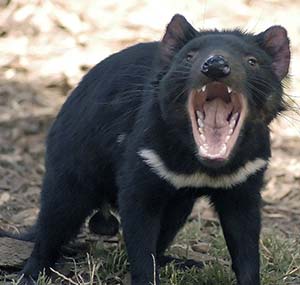Chromosomes, Telomeres, and Tasmanian Devils

Devil Facial Tumor Disease (DFTD) ia a type of cancer that is transmissible. A tasmanian devil can infect another tasmanian devil with the disease when they bite each other. The infection causes tumors to form around the face and mouth, which can ultimately restrict the animal’s ability to eat or its ability to see. Most devils die within six months of the initial tumor formation.
Since 1996, DFTD has decimated 85% of the entire population of Tasmanian devils. To save the species, scientists have started captive breeding projects and are working to develop a vaccine.
DFTD cells have a unique feature: these cells do not age or die, which makes it challenging to find cures or treatments.
Why are these cells immortal?
Normally, cells can only divide so many times, eventually reaching a point where they can no longer make new cells. This normal process of cell aging is called senescence and is associated with several conditions within the cell, one of which is the telomeres of chromosomes.
A telomere is a cap on the end of a chromosome that contains a section on noncoding DNA. A telomere is like the plastic cap at the end of a shoelace. Each time the cell divides this area of the chromosome gets shorter. Eventually, the telomeres get so short that cell can no longer copy its DNA and cannot divide. The telomeres of the DFTD cancer cells do not shorten with each cell division, so the cells do not age, they are essentially immortal cells.
Another feature of DFTD is the chromosome makeup of the cancer cells. Normally, Tasmanian devil cells have 14 chromosomes. The oldest-known strain of the tumour cells have thirteen chromosomes, nine of which are recognisable and four of which are mutated "marker" chromosomes. Newer strains have an additional marker chromosome for a total of 14. Among the mutations present, is trisomy of chromosome 5; these cells have an extra copy of this chromosome instead of the two found in normal cells.

1. What is a transmissible cancer?
2. How do Tasmanian Devils die from the disease?
3. What is senescence?
4. What feature of the DFTD cells makes them immortal?
5. Describe a telomere:
6. How do chromosomes of a DFTD cell differ from a normal cell?
7. What is TRISOMY?
8. What can be done to save the species?





